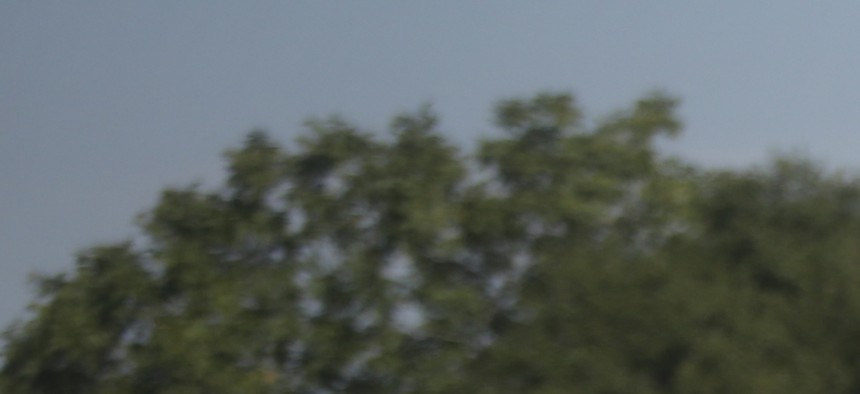
Ukranian soldiers take positions in the village of Bezimenne in southeastern Ukraine, on August 26, 2014. Sergei Grits/AP
Obama Says Still No Ukraine Intervention As More Russians Cross Border
After NATO released imagery showing Russian combat troops fighting inside Ukraine’s border, Obama refused to use the i-word—or offer military assistance to Kiev. By Ben Watson
In the face of the most damning evidence to date that Russian troops and equipment have invaded Ukraine, President Barack Obama on Thursday stuck to previous statements that there is no military solution to the ongoing crisis there.
“We are not taking military action to solve the Ukrainian problem,” Obama said from the White House Thursday. “What we're doing is [mobilizing] the international community to apply pressure on Russia. But I think it is very important to recognize that a military solution to this problem is not going to be forthcoming.”
Early Thursday, NATO officials said Russia had sent more than 1,000 troops into Ukraine to join separatists fighting Ukrainian armed forces. NATO also released satellite imagery showing the movement of Russian artillery, vehicles and troops in and around Ukraine’s eastern border with Russia.

"If reports prove accurate that Putin has in fact sent over 1,000 troops into Ukraine to support and fight alongside Russian-backed separatists, this is an act of war against the sovereign state of Ukraine,” said House Armed Services Committee Chairman Buck McKeon, R-Calif., and Rep. Michael Turner, R-Ohio. "The President needs to definitively state whether or not Russia has invaded Ukraine and immediately condemn this overt escalation of an already serious conflict.”
Sens. John McCain, R-Ariz., and Lindsay Graham, R-S.C., also released a heated statement Thursday on the crisis in Eastern Europe. “Russia's ongoing aggression in Ukraine can only be called one thing: a cross-border military invasion,” the senators said.
Even a member of Russian President Vladimir Putin’s advisory council on human rights, Ella Polyankova, referred to Thursday’s action as an invasion. "When masses of people, under commanders' orders, on tanks, [armored personnel carriers] and with the use of heavy weapons, [are] on the territory of another country, cross the border, I consider this an invasion," she told Reuters.
But Obama avoided using the word “invasion” on Thursday, preferring the less-confrontational categorization of Russian actions as a violation of Ukraine’s “sovereignty and territorial integrity.”
“I just spoke with Chancellor Merkel of Germany on the situation in Ukraine,” Obama said. “We agree, if there was ever any doubt, that Russia is responsible for the violence in Eastern Ukraine … As a result of the actions Russia has already taken and the major sanctions we've imposed with our European and international partners, Russia is already more isolated than at any time since the end of the Cold War.”
Obama is off to Europe next week for a visit to Estonia ahead of a NATO summit in Wales with all 28 member states. Ukrainian President Petro Poroshenko is also planning to attend that meeting; and he’ll make his first trip to the White House later in September.
On Wednesday, NATO chief Anders Fogh Rasmussen gave reporters a preview of the September summit's agenda, which includes plans to deploy alliance troops to multiple, but so far unnamed, Eastern European bases "with a very high frequency...as long as necessary."
He also previewed a plan to create a rapidly deployable version of NATO’s current Response Force. That force is composed of roughly 13,000 special operations forces, along with land, air and sea assets.
"It's our intention to develop what I would call a spearhead within that response force at very, very high readiness," Rasmussen said.
NATO’s Dutch Brig. Gen. Nico Tak, director of the alliance’s Comprehensive Crisis and Operations Management Centre, said the past two weeks have shown “a significant escalation in both the level and sophistication of Russia’s military interference in Ukraine,” previewing such a move.
"Russia’s ultimate aim is to alleviate pressure on separatist fighters in order to prolong this conflict indefinitely,” he said, “which would result in further tragedy for the people of Eastern Ukraine.”
Separatist leader Alexander Zakharchenko admitted Thursday that up to 4,000 Russians are fighting with the separatists, Russian news agency ITAR-Tass reported. Russia continues to pour in artillery, paratroopers and even special forces troops into the region, with the latest supply as recently as mid-August. But Ukraine’s increasingly desperate pleas for international help—the subject of a U.N. Security Council meeting Thursday afternoon—have thus far gone largely unanswered. They include repeated requests for military equipment from Washington, which has so far only sent non-lethal aid to Ukrainian troops.
“In the last 48 hours, Russia’s actions have spoken volumes,” U.S. Ambassador to the U.N. Samantha Power said Thursday. “Just this Tuesday, after meeting with Ukrainian President Poroshenko in Minsk, Belarus, Putin spoke of the need to quote ‘end bloodshed as soon as possible’…The day after those talks, Russia fired Grad rockets from inside Russia at Ukrainian positions in Novoazovsk, and then attacked with two columns of Russian armored vehicles and tanks.”
Given Russia’s escalation this week, Poroshenko’s two September meetings could not come soon enough for the more than 155,000 Ukrainians who have been displaced since fighting began at least four months ago, according to the U.N. More than 2,200 have died from fighting in Ukraine since April, eclipsing the 2,140 U.S. troop deaths in Afghanistan over the last 13 years.
NEXT STORY: Obama: 'We Don’t Have a Strategy Yet'



